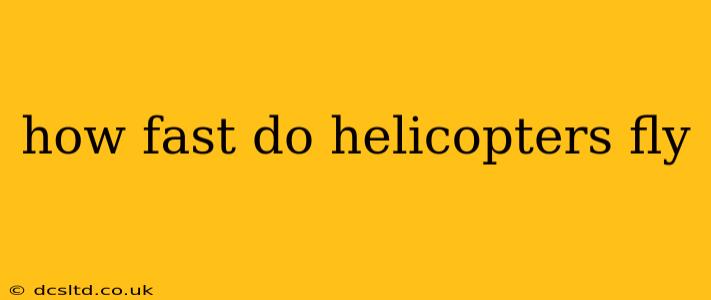Helicopters, with their remarkable ability to take off and land vertically, are fascinating machines. But just how fast can these rotary-winged aircraft actually fly? The answer, unfortunately, isn't a single, simple number. Helicopter speed is highly variable, depending on several key factors. This comprehensive guide will delve into the intricacies of helicopter speed, exploring the different factors influencing it and answering some frequently asked questions.
What is the Average Speed of a Helicopter?
The average cruising speed of a helicopter falls within the range of 80 to 150 miles per hour (130 to 240 kilometers per hour). However, this is a broad average. Smaller, lighter helicopters tend to be on the lower end of this range, while larger, more powerful models can reach the higher speeds. Maximum speeds can exceed this range, but these are typically only achieved under specific conditions.
What Factors Affect Helicopter Speed?
Several factors significantly impact a helicopter's speed:
-
Helicopter Model and Size: Larger helicopters with more powerful engines generally fly faster than smaller ones. The design and aerodynamics of the helicopter also play a crucial role.
-
Weight and Payload: A heavier helicopter carrying a significant load will naturally be slower than the same model with a lighter payload. This is due to increased drag and reduced engine efficiency.
-
Altitude and Temperature: Higher altitudes mean thinner air, resulting in reduced lift and potentially lower speeds. Similarly, higher temperatures decrease air density, impacting performance.
-
Wind Conditions: Headwinds will reduce a helicopter's ground speed, while tailwinds will increase it. Strong crosswinds can also impact maneuverability and speed.
-
Engine Performance: The health and efficiency of the engine are critical. A well-maintained engine will deliver optimal performance, contributing to higher speeds.
How Fast Can Different Types of Helicopters Fly?
The speed of a helicopter varies significantly depending on its type and purpose. Here are some examples:
-
Light Helicopters: These generally have cruising speeds in the 80-120 mph (130-190 km/h) range. They are often used for personal or light commercial tasks.
-
Medium Helicopters: These can reach speeds of 120-150 mph (190-240 km/h) and are suitable for a wider range of applications, including emergency medical services (EMS) and corporate transport.
-
Heavy Helicopters: These are the largest and most powerful helicopters, capable of achieving speeds of up to 150 mph (240 km/h) or more. They are primarily used for heavy lifting, cargo transport, and specialized operations.
What is the Fastest Helicopter in the World?
While precise speed records can be difficult to definitively verify, some helicopters are known for their high speeds. The Sikorsky X2, a technological demonstrator, achieved speeds significantly exceeding those of standard helicopters, though it's not a production model. Therefore, it's more accurate to focus on the top speeds of production models which fall in the 150-180mph range, depending on conditions.
Can Helicopters Fly Faster Than Airplanes?
No, generally speaking, helicopters cannot fly as fast as fixed-wing airplanes. Airplanes are designed for aerodynamic efficiency at high speeds, while helicopters' rotor system inherently limits their top speed.
What is the Maximum Speed a Helicopter Can Reach?
The maximum speed a helicopter can reach varies greatly depending on the factors discussed earlier. While some helicopters may briefly exceed 150 mph in ideal conditions, this is not a sustainable cruising speed. It's more accurate to consider the cruising speed as a better indicator of a helicopter’s typical performance.
How Does Helicopter Speed Compare to Other Aircraft?
Compared to airplanes, helicopters are significantly slower. Airplanes benefit from streamlined designs optimized for speed. Helicopters, on the other hand, prioritize maneuverability and vertical lift capabilities.
This exploration into helicopter speed highlights the complexity of the topic. Remember that the figures provided are averages, and actual speeds will vary depending on numerous factors. This understanding is crucial for anyone interested in the fascinating world of rotary-wing aviation.
